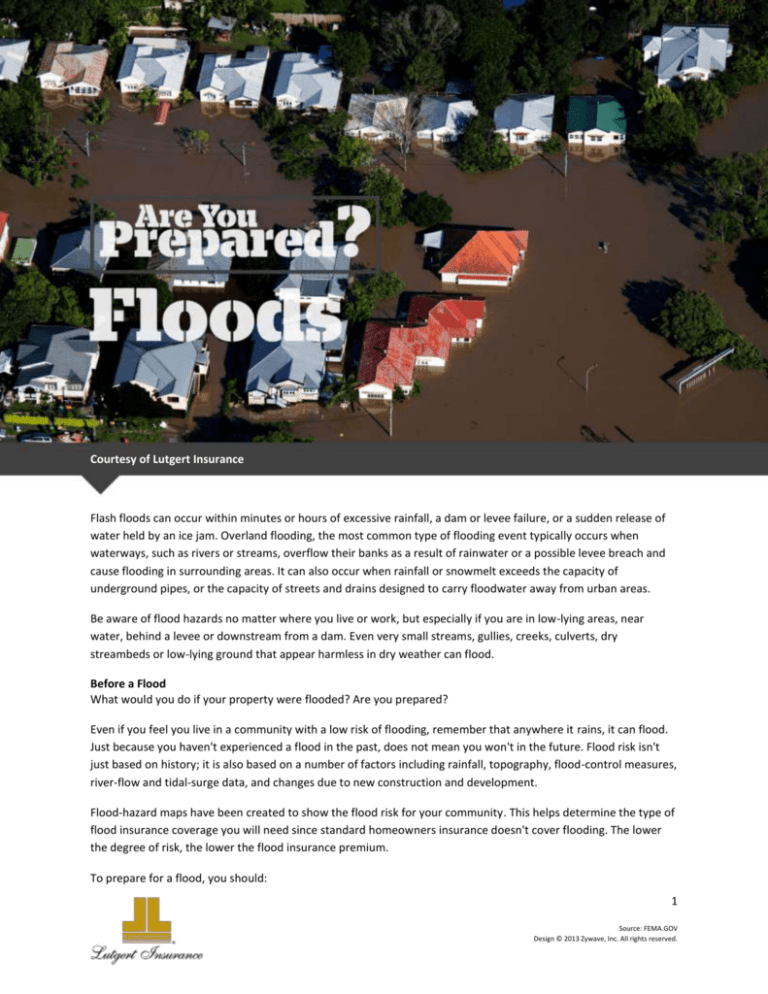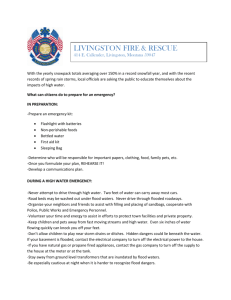
Courtesy of Lutgert Insurance
Flash floods can occur within minutes or hours of excessive rainfall, a dam or levee failure, or a sudden release of
water held by an ice jam. Overland flooding, the most common type of flooding event typically occurs when
waterways, such as rivers or streams, overflow their banks as a result of rainwater or a possible levee breach and
cause flooding in surrounding areas. It can also occur when rainfall or snowmelt exceeds the capacity of
underground pipes, or the capacity of streets and drains designed to carry floodwater away from urban areas.
Be aware of flood hazards no matter where you live or work, but especially if you are in low-lying areas, near
water, behind a levee or downstream from a dam. Even very small streams, gullies, creeks, culverts, dry
streambeds or low-lying ground that appear harmless in dry weather can flood.
Before a Flood
What would you do if your property were flooded? Are you prepared?
Even if you feel you live in a community with a low risk of flooding, remember that anywhere it rains, it can flood.
Just because you haven't experienced a flood in the past, does not mean you won't in the future. Flood risk isn't
just based on history; it is also based on a number of factors including rainfall, topography, flood-control measures,
river-flow and tidal-surge data, and changes due to new construction and development.
Flood-hazard maps have been created to show the flood risk for your community. This helps determine the type of
flood insurance coverage you will need since standard homeowners insurance doesn't cover flooding. The lower
the degree of risk, the lower the flood insurance premium.
To prepare for a flood, you should:
1
Source: FEMA.GOV
Design © 2013 Zywave, Inc. All rights reserved.
Build an emergency kit and make a family communications plan. Please contact Lutgert Insurance if you
would like us to provide you with an emergency kit
checklist or sample family communications plan.
Avoid building in a floodplain unless you elevate and
reinforce your home.
Elevate the furnace, water heater and electric panel in
your home if you live in an area that has a high flood risk.
Consider installing "check valves" to prevent floodwater
from backing up into the drains of your home.
If feasible, construct barriers to stop floodwater from
entering the building and seal walls in basements with
waterproofing compounds.
Driving: Flood Facts
Six inches of water will reach
the bottom of most
passenger cars causing loss of
control and possible stalling.
A foot of water will float
many vehicles.
Two feet of rushing water can
carry away most vehicles
including sport utility vehicles
(SUVs) and pick-ups.
Do not attempt to drive
through a flooded road. The
depth of water is not always
obvious. The roadbed may be
washed out under the water,
and you could be stranded or
trapped.
Do not drive around a
barricade. Barricades are
there for your protection.
Turn around and go the other
way.
During a Flood
If a flood is likely in your area, you should:
Listen to the radio or television for information.
Be aware that flash flooding can occur. If there is any
possibility of a flash flood, move immediately to higher
ground. Do not wait for instructions to move.
Be aware of stream, drainage channels, canyons and other
areas known to flood suddenly. Flash floods can occur in
these areas with or without typical warnings such as rain
clouds or heavy rain.
If you must prepare to evacuate, you should do the following:
Secure your home. If you have time, bring in outdoor
furniture. Move essential items to an upper floor.
Turn off utilities at the main switches or valves if
instructed to do so. Disconnect electrical appliances. Do
not touch electrical equipment if you are wet or standing
in water.
Do not try to take short cuts.
They may be blocked. Stick to
designated evacuation routes.
Be especially cautious driving
at night when it’s more
difficult to recognize flood
dangers.
If you have to leave your home, remember these evacuation tips:
Do not walk through moving water. Six inches of moving
water can make you fall. If you have to walk in water, walk where the water is not moving. Use a stick to
check the firmness of the ground in front of you.
Do not drive into flooded areas. If floodwaters rise around your car, abandon the car and move to higher
ground if you can do so safely. You and the vehicle can be swept away quickly.
Do not camp or park your vehicle along streams, rivers or creeks, particularly during threatening
conditions.
2
After a Flood
Your home has been flooded. Although floodwaters may be down in
some areas, many dangers still exist. Here are some things to
remember in the days ahead:
Use local alerts and warning systems to get information and
expert informed advice as soon as available.
Avoid moving water.
Stay away from damaged areas unless your assistance has
been specifically requested by police, fire, or a relief
organization.
Flood Insurance: What You
Should Know
A standard homeowner’s
insurance policy does not cover
damages from flooding. A
separate flood policy is needed to
cover losses to your property
caused by flooding, including:
Structural damage
Stay off the roads and out of the way as emergency
workers assist people in flooded areas.
Furnace, water heater
and air conditioner
Play it safe. Additional flooding or flash floods can occur.
Listen for local warnings and information. If your car stalls
in rapidly rising waters, get out immediately and climb to
higher ground.
Flood debris clean up
Floor surfaces (carpeting
and tile)
Return home only when authorities indicate it is safe.
Take another route if you come upon a barricade or
flooded road. Roads may still be closed because they have
been damaged or are covered by water. Barricades have
been placed for your protection.
If you must walk or drive in areas that have been flooded:
You can also purchase a flood
insurance policy to cover the
contents of your home, such as
furniture, collectibles, clothing,
jewelry and artwork.
You insurance broker can assist
you in determining your flood risk
and coverage options.
o
Stay on firm ground. Moving water only 6 inches deep
can sweep you off your feet. Standing water may be
electrically charged from underground or downed
power lines.
o
Flooding may have caused familiar places to change. Floodwaters often erode roads and walkways.
Flood debris may hide animals and broken bottles, and it's also slippery. Avoid walking or driving
through it.
Be aware of areas where floodwaters have receded. Roads may have weakened and could collapse under
the weight of a car.
Stay out of any building if it is surrounded by floodwaters.
Use extreme caution when entering buildings; there may be hidden damage, particularly in foundations.
Staying Healthy
A flood can cause physical hazards and emotional stress. You need to look after yourself and your family as you
focus on cleanup and repair.
Avoid floodwaters; water may be contaminated by oil, gasoline or raw sewage.
3
Service damaged septic tanks, cesspools, pits and leaching systems as soon as possible. Damaged sewer
systems are serious health hazards.
Listen for news reports to learn whether the community’s water supply is safe to drink.
Clean and disinfect everything that got wet. Mud left from floodwaters can contain sewage and
chemicals.
Keep a manageable schedule. Make a list and do jobs one at a time.
Contact your insurance agent to discuss claims.
In addition to insuring your home, Lutgert Insurance is committed to helping you and your loved ones stay safe
when disaster strikes. If you would like more information on developing a family emergency plan or building a
disaster supply kit, please contact us at 239-262-7171 or www.lutgertinsurance.com today.
4






